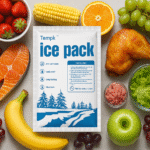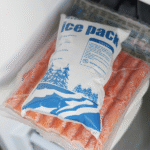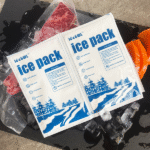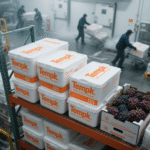Pacotes de gelo seco reutilizáveis para transporte de peixes: Como manter frutos do mar congelados
Manter os frutos do mar congelados quando viajam é crucial para o sabor e a segurança. Bolsas de gelo seco reutilizáveis para peixes torná-lo simples e econômico fornecendo temperaturas ultra frias sem bagunça. Neste guia você aprenderá por que as bolsas de gelo seco funcionam melhor do que o gelo normal, como embalar o peixe corretamente e como 2025 inovações podem impulsionar sua cadeia de frio. Prepare-se para manter seus embarques de pescado congelados e os clientes satisfeitos.

O que são bolsas de gelo seco reutilizáveis e como funcionam?—compreendendo a sublimação de CO₂ sólido para remessas de pescado
Por que escolher bolsas de gelo seco em vez de bolsas de gel ou gelo de água?—comparando a duração do resfriamento, faixa de temperatura e umidade
Como embalar peixes com segurança com bolsas de gelo seco?—calculando quantidades, técnicas de estratificação e ventilação
Qual bolsa de gelo seco combina com seus frutos do mar?—escolhendo por tipo de peixe, duração da remessa e metas de sustentabilidade
Quais são as últimas tendências da cadeia de frio para peixes?—monitoramento inteligente, CO₂ ecologicamente correto e resfriamento híbrido
O que são bolsas de gelo seco reutilizáveis para peixes e como funcionam?
Definindo bolsas de gelo seco em termos simples
Bolsas de gelo seco são folhas ou tijolos contendo dióxido de carbono sólido (Co₂) que sublimam de um sólido diretamente para um gás, Mantendo temperaturas extremamente baixas. Quando usado em um saco ou pacote ventilado, o gás CO₂ escapa enquanto o ar frio afunda ao redor dos peixes. Ao contrário da água congelada, gelo seco não derrete em líquido, por isso evita embalagens encharcadas e evita o crescimento bacteriano. Esses pacotes normalmente sublimam em –78,5 ° C. (–109,3°F), tornando-os ideais para manter peixes congelados durante remessas longas.
As bolsas de gelo seco reutilizáveis usam materiais duráveis e designs ventilados para que possam ser recarregado—depois que o CO₂ sublima completamente, você pode reabastecer ou substituir as pelotas de gelo seco. Isso reduz o desperdício e economiza dinheiro em relação aos blocos de uso único. Ao recongelar, certifique-se de que a embalagem esteja totalmente sublimada e seca antes de adicionar gelo seco fresco.
Comparação dos pacotes de gelo seco reutilizáveis com os pacotes de gel para peixes
Os pacotes de gel são bolsas flexíveis preenchidas com um gel não tóxico que congela e mantém temperaturas frias ao redor 0 °C–8 °C (32 °F–46°F). Eles são reutilizáveis e não tóxicos, tornando-os ótimos para frutos do mar refrigerados ou entregas de curta distância. Pacotes de gelo seco, no entanto, manter temperaturas abaixo de –78,5°C e durar 24–48 horas ou mais, tornando-os indispensáveis para peixe congelado ou remessas de longa distância. Pacotes de gel geram água derretida e podem permitir flutuações de temperatura, enquanto as bolsas de gelo seco não deixam resíduos.
| Método de resfriamento | Faixa de temperatura | Duração | Umidade | Uso prático |
| Pacote de gelo seco | –78,5 ° C. (–109 ° F.) | 24–48 horas, até 72 horas em condições ideais | Nenhum (Sublelimates) | Melhor para peixe congelado ou remessas de longa distância; compacto e sem resíduos |
| Pacote de gel | 0 °C–8 °C (32 °F–46°F) | 6–12 horas | Produz água derretida | Ideal para frutos do mar refrigerados ou viagens curtas; reutilizável e flexível |
| Pacote de gelo de água | ~ 0 ° C. (32 ° f) | 6–8 horas | Derrete em líquido | Opção de baixo custo para entregas não perecíveis ou locais |
Por que a sublimação é importante para os peixes
O gelo seco passa diretamente de um sólido para um gás. Como se sublima, isto absorve calor do seu peixe, mantendo o produto congelado. O gás CO₂ frio afunda dentro do recipiente, formando uma “cúpula fria” sobre o seu peixe. Porque não há derretimento, sua embalagem permanece seca e seus peixes chegam sem danos causados pela água.
Dica prática para você
Use uma bolsa de gelo seco reutilizável ao enviar peixe congelado em todo o país ou internacionalmente; a temperatura ultra baixa evita o descongelamento durante o trânsito de vários dias.
Escolha pacotes de gel para frutos do mar frescos ou vivos; eles mantêm temperaturas geladas sem congelar o produto.
Caso real: Um distribuidor de frutos do mar que envia atum fresco para o exterior usou bolsas de gelo seco reutilizáveis combinadas com revestimentos isolados. O peixe chegou congelado após uma viagem de 48 horas, sem resíduos de água e com inspeções alfandegárias satisfeitas - comprovando a eficácia do resfriamento baseado em sublimação.
Por que os pacotes de gelo seco reutilizáveis são essenciais para o transporte de peixes?
Manter a segurança e a qualidade dos alimentos
O peixe é altamente perecível e deve ser mantido em temperaturas abaixo de zero para evitar o crescimento bacteriano e a deterioração.. As bolsas de gelo seco mantêm temperaturas consistentes abaixo de –18°C, garantindo que o peixe congelado permaneça sólido e fresco. Pacotes de gel tradicionais ou gelo de água podem permitir que a temperatura flutue, arriscando descongelamento parcial e comprometendo a qualidade.
Principais benefícios para a logística de frutos do mar
Duração de resfriamento prolongada: O gelo seco dura mais que o gelo normal; o processo de sublimação pode fornecer resfriamento contínuo por 24 a 48 horas ou mesmo até 72 horas com o tamanho certo da embalagem.
Nenhum resíduo ou contaminação: Porque o gelo seco sublima, vai embora Sem líquido atrás, evitando embalagens encharcadas e reduzindo o risco de bactérias.
Compacto e leve: As bolsas de gelo seco são economia de espaço, maximizando o volume de remessa e reduzindo os custos de remessa.
Opção reutilizável: Muitos produtos de gelo seco são reutilizável, permitindo que você os recarregue com novos pellets de CO₂ após cada viagem. Isto reduz o desperdício e os custos a longo prazo.
Casos de uso por tipo de peixe
Bolsas de gelo seco reutilizáveis são adequadas para diferentes tipos de peixes:
Peixe fresco: Peixe pré-resfriado requer temperaturas logo acima de zero. As bolsas de gelo seco mantêm um ambiente fresco para evitar a deterioração e ao mesmo tempo evitar o descongelamento.
Peixe congelado: O peixe congelado deve permanecer abaixo de –18°C. As bolsas de gelo seco mantêm temperaturas abaixo de zero para evitar o descongelamento.
Produtos de peixe processados: Peixe ou filé defumado precisam de condições de frio estáveis para preservar a qualidade. O gelo seco fornece resfriamento consistente.
Para a ponta
Ao transportar peixe ou marisco vivo, não use gelo seco. O frio extremo pode prejudicar os animais. Em vez de, use pacotes de gel ou água gelada para manter um ambiente resfriado, mas não congelado.
Quanto gelo seco usar e melhores práticas para embalar peixes
Determinando a capacidade de resfriamento necessária
Estimar a quantidade de gelo seco necessária é crucial para remessas econômicas e seguras. Uma regra geral é de 5 a 10 libras de gelo seco para cada 15 litros de espaço mais frio por trânsito de 24 horas. Para viagens mais longas ou climas quentes, aumentar o valor proporcionalmente.
As diretrizes da UPS sugerem cinco a dez libras de gelo seco sublimarão a cada 24 horas, dependendo da densidade do recipiente isolado. Eles recomendam adicionar gelo seco suficiente para cobrir um extra 24 horas em caso de atrasos. A Insulated Products Corporation também observa que o uso gelo seco de peso igual e carga útil manterão o produto congelado por até 48 horas, e uma vez e meia o peso é necessário para envio em 72 horas.
Técnica adequada de embalagem e estratificação
Siga estas etapas para maximizar o desempenho:
Escolha um isolamento de qualidade: Use recipientes feitos de poliestireno expandido (EPS) ou poliuretano para resistência térmica. Evite caixas herméticas – deixe espaço para o gás escapar.
Pré congelar e pré resfriar: Sempre congele o peixe e resfrie seu recipiente antes de embalar; isso reduz a carga de temperatura inicial.
Camada sua remessa:
Camada inferior: Coloque espuma ou papelão para criar um amortecedor.
Camada intermediária: Organize os pedaços de peixe uniformemente com espaço para circulação de ar.
Camada superior: Posicione bolsas de gelo seco em cima para criar uma cúpula fria, permitindo que o ar frio afunde ao redor do peixe.
Preencha espaços vazios: Use papel amassado ou isolamento extra para eliminar lacunas de ar e reduzir o consumo de gelo seco.
Fornece ventilação: Deixe aberturas de ventilação ou pequenas rachaduras na tampa do recipiente para que o gás CO₂ possa escapar, evitando o aumento da pressão. Nunca feche hermeticamente uma caixa de gelo seco.
Separe o gelo seco dos peixes: Use um espaçador ou camada de papelão para evitar contato direto. O frio extremo do gelo seco pode causar queimaduras de congelamento se tocar em peixes.
Use registradores de dados: Anexe um registrador de temperatura para monitorar as condições durante a viagem; isso ajuda você a validar seu processo e cumprir os regulamentos.
Considerações regulatórias e de segurança
Classificação de perigo: O gelo seco é classificado como um material perigoso (E 1845). Os EUA. O Código de Regulamentações Federais e as regras da IATA limitam as remessas aéreas a cerca de 2.5 kg (5.5 Libra) de gelo seco por pacote.
Precauções de manuseio: Use luvas de proteção, óculos de proteção e mangas compridas para evitar queimaduras pelo frio. Use pinças quando possível, e nunca manuseie gelo seco com as mãos desprotegidas.
Ventilação e armazenamento: Armazene gelo seco em áreas bem ventiladas e em recipientes não herméticos. O gás CO₂ pode acumular-se e causar aumento de pressão ou asfixia.
Disposição: Deixe as sobras de gelo seco sublimarem ao ar livre ou em um espaço bem ventilado; nunca descarte-o em pias ou lixeiras.
Caso real: Uma pequena pescaria uma vez selou um pacote de gelo seco com muita força. O gás CO₂ acumulou-se e estourou a caixa durante o transporte. Seguindo as diretrizes adequadas de ventilação e rotulagem, você pode evitar esses acidentes e manter suas remessas seguras para transportadoras e clientes.
Escolhendo o pacote de gelo seco reutilizável certo para diferentes remessas de peixes
Avalie a duração da remessa e os requisitos de temperatura
Viagens curtas (menos de 24 horas): Para entregas locais ou remessas noturnas, use gelo seco no valor de metade do peso do seu peixe para mantê-lo congelado.
Viagens médias (24–48 horas): Peso igual de gelo seco e peixe mantém o congelamento por até 48 horas.
Viagens prolongadas (48–72hours): Usar 1.5 vezes o peso do seu peixe em gelo seco para manter o congelamento por 72 horas. Adicione pacotes de gel para retardar a sublimação e prolongar o resfriamento.
Combine o tamanho da embalagem com o volume do peixe
Considere o tamanho da sua remessa: remessas maiores exigem vários pacotes reutilizáveis para distribuir o resfriamento uniformemente. Para remessas pequenas ou moderadas, um pacote pode ser suficiente. Certifique-se sempre de que cada pacote esteja totalmente carregado com pellets de gelo seco antes de usar.
Considere o tipo de peixe e as necessidades do cliente
Filetes premium e peixes delicados: Use isolamento extra e mais gelo seco para evitar qualquer aumento de temperatura; clientes que pagam por frutos do mar premium esperam qualidade imaculada.
Peixe congelado a granel: Eficiência é importante; escolha pacotes maiores ou vários pacotes menores para maximizar o espaço do contêiner e minimizar o custo por quilo.
Clientes com mentalidade sustentável: Selecione embalagens feitas de materiais recicláveis ou gelo seco ecológico produzido através de processos de captura de carbono. Comunicar este esforço de sustentabilidade aos clientes para aumentar o valor da marca.
Considere a reutilização e a sustentabilidade
Bolsas de gelo seco reutilizáveis reduzem o impacto ambiental, permitindo o uso repetido. Alguns fabricantes agora oferecem pacotes de gelo seco inteligentes com sensores integrados que monitoram a temperatura e alertam caso as condições se desviem. Outros usam CO₂ biodegradável para minimizar as emissões. Ao escolher um pacote, avaliar durabilidade, facilidade de recarga e reciclabilidade em fim de vida.
2025 Tendências em bolsas de gelo seco reutilizáveis e logística de cadeia de frio para peixes
Visão geral da tendência
A indústria de frutos do mar está passando por uma rápida inovação na logística da cadeia de frio. As tecnologias emergentes estão tornando o transporte marítimo mais seguro, mais verde e mais eficiente. Iniciativas de sustentabilidade estão impulsionando a adoção de processos de fabricação de gelo seco biodegradável e captura de carbono. Monitoramento inteligente usa sensores IoT para monitorar a temperatura em tempo real, garantindo a conformidade e reduzindo a deterioração. Soluções de refrigeração híbrida combinar gelo seco com materiais de mudança de fase (PCM) ou pacotes de gel para prolongar o tempo de resfriamento e reduzir a quantidade de gelo seco necessária.
Resumo dos últimos avanços
Pacotes de gelo seco inteligentes: Equipado com sensores IoT, esses pacotes fornecem dados de temperatura em tempo real e alertas se a remessa sair da faixa segura.
Produção ecológica de CO₂: Inovações usam energia renovável e captura de carbono para produzir gelo seco, reduzindo a pegada de carbono do transporte marítimo.
Resfriamento híbrido: A combinação de gelo seco com pacotes de gel ou PCM prolonga a duração do resfriamento e reduz o consumo de gelo seco.
Otimização da cadeia de frio orientada por IA: Inteligência artificial otimiza rotas, prevê atrasos e ajusta as necessidades de resfriamento, garantindo que o peixe chegue fresco.
Insights de mercado
A crescente demanda do consumidor por alimentos frescos, frutos do mar de origem sustentável estão incentivando o mercado da cadeia de frio a adotar embalagens reutilizáveis e monitoramento avançado. As embalagens reutilizáveis e a logística mais inteligente não só reduzem o desperdício, mas também custos de envio mais baixos reduzindo a deterioração e as devoluções. Esperamos que o mercado de embalagens reutilizáveis da cadeia de frio se expanda significativamente durante a próxima década, à medida que as regulamentações enfatizam a redução de carbono e os consumidores favorecem práticas sustentáveis.
Perguntas frequentes
Por quanto tempo as bolsas de gelo seco reutilizáveis manterão os peixes congelados? Bolsas de gelo seco podem manter os peixes congelados por 24–48 horas, e até 72 horas ao usar quantidades maiores ou combinar com pacotes de gel.
As bolsas de gelo seco são seguras para manusear? Sim, se manuseado corretamente. Use sempre luvas e óculos de proteção, e evite contato direto com a pele nua. Forneça ventilação para liberar gás CO₂.
Posso reutilizar pacotes de gelo seco? Sim. Depois que o gelo seco sublimar totalmente, deixe a embalagem secar e recarregue-a com novos pellets de CO₂. Certifique-se de que não haja umidade ou danos antes de reutilizar.
O gelo seco é adequado para peixes ou mariscos vivos? Não. O frio extremo pode prejudicar frutos do mar vivos. Use pacotes de gel ou água gelada.
Quais regulamentos se aplicam às remessas de gelo seco? O gelo seco é um material perigoso (E 1845). As remessas aéreas são normalmente limitadas a 2.5 kg (5.5 Libra) por pacote e exigem rotulagem específica.
Resumo
Bolsas de gelo seco reutilizáveis são uma ferramenta poderosa para preservar a qualidade do peixe durante o transporte. Eles manter temperaturas ultrabaixas sem umidade, oferecer durações de resfriamento prolongadas, e reduzir o desperdício quando reutilizado. Por calculando a quantidade certa de gelo seco, estratificando sua remessa adequadamente e garantindo ventilação, você pode manter o peixe congelado por dias. Com tendências emergentes, como sensores inteligentes e produção ecológica de CO₂, bolsas de gelo seco reutilizáveis continuarão a melhorar. Para melhores resultados, avalie suas necessidades de remessa, escolha isolamento de alta qualidade e mantenha-se informado sobre atualizações regulatórias.
PRÓXIMOS PASSOS:
Avalie suas remessas: Determine se seus peixes precisam ser congelados ou resfriados, e calcule o peso necessário do gelo seco de acordo.
Atualize sua embalagem: Invista em durável, bolsas de gelo seco reutilizáveis e recipientes isolados para melhorar a eficiência.
Implementar monitoramento: Use registradores de temperatura ou pacotes inteligentes para monitorar condições e ajustar processos em tempo real.
Mantenha-se sustentável: Explore fontes de gelo seco ecologicamente corretas e opções de reciclagem para reduzir o impacto ambiental.
Obtenha suporte profissional: Consulte especialistas em cadeia de frio para personalizar uma solução para o seu negócio.
Sobre temperatura
Somos especializados em logística avançada da cadeia de frio para frutos do mar, produtos farmacêuticos e outros produtos perecíveis. Nossos pacotes de gelo seco reutilizáveis, caixas isoladas e ferramentas de monitoramento inteligentes ajudam você a manter a integridade do produto e, ao mesmo tempo, reduzir custos. Estamos comprometidos com a sustentabilidade, oferecendo materiais ecológicos e tecnologia de ponta. Com nossa experiência, você pode enviar peixes com confiança, sabendo que chegará congelado, seguro e pronto para os consumidores.
Chamado à ação: Explore nossos produtos e fale hoje mesmo com um consultor Tempk para otimizar seu processo de envio de pescado.























